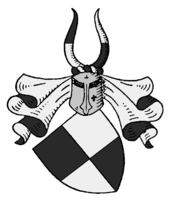Gut Boyneburgk
| Gut Boyneburgk | ||
|---|---|---|
| Alternative name (s): | Hofgut Datterpfeife, Rittergut Boyneburgk | |
| Creation time : | 15th century at the latest | |
| Castle type : | Manor | |
| Conservation status: | received, Hofgut | |
| Standing position : | Noble | |
| Place: | Sontra - Wichmannshausen | |
| Geographical location | 51 ° 6 '9.4 " N , 9 ° 59' 58.9" E | |
| Height: | 339 m above sea level NHN | |
|
|
||
The Boyneburgk estate near Wichmannshausen , a district of the town of Sontra in the Werra-Meißner district in northern Hesse , is a former manor with a long history. It was first mentioned in a document in 1460 and has been owned by the von Boyneburg and von Boyneburgk families since then .
location
The estate is 339 m above sea level. NN in the district Wichmannshausen west below the Boyneburg at the foot of the wooded mountain Boyneburg ( 513 m above sea level ), about 2 km east-southeast of Wichmannshausen. Boyneburgk Castle is around 150 m further south .
The brook “Datterpfeife” rises between the manor and the castle, which first feeds a small pond there, then flows west, takes up the “Hinterbach”, which rises about 500 m northeast of the manor, and after about 3 km in Wichmannshausen about 300 m north of the mouth of the Ulfe also flows into the Sontra .
Surname
The estate (or Vorwerk ) was known under the name Datterpfeife well into the 20th century. The name is interpreted as Bifang der Tattern , whereby " Bifang ", the old name for a large pasture, became "pipe" and the Tattern are said to have been a subgroup of a Wendish tribe that was settled in the area.
history
From the middle of the 15th century, the various branches of the von Boyneburg family left their castle seats on the Boyneburg and moved to their estates in the valley. When the Datterpfeife estate was first mentioned in 1460, when the Boyneburgers finally compared themselves with Landgrave Ludwig II of Hesse and accepted the Boyneburg and the villages belonging to their territory as an after-fief from the Landgrave, the tribe "Boyneburgk-Stedtfeld" became the fiefdom of the good. Eleven years later, the “Boyneburg-Hohenstein” tribe is named as the tenant of a second farm on the “Toderpieffe”. According to H. Reimer , around 1600 the estate had a tower in addition to the house, which was shown on a map of the Boyneburg and Eschwege courts .
The “Wichmannshausen” tribe moved to their estate in Wichmannshausen. Since the Boyneburg-Honstein family line expired in 1792 and the Boyneburg-Bischhausen and Laudenbach line in 1803 in the male line, their allodial ownership fell to the Boyneburg-Stedtfeld and Wichmannshausen line that still existed, which is not only the sole owner of the now ruined line Boyneburg, but also the Datterpfeife estate and the extensive forests in the Werra area.
The estate in Wichmannshausen with the Old Boyneburg Castle became a Hessian state domain in 1803 , but the Datterpfeife Vorwerk remained Boyneburg property. From this year the family lived on the Boyneburgk estate, which for centuries had only housed manager or tenant families as the Datterpfeife farm , but then finally built Boyneburgk Castle about 150 m south of the farm buildings .
Notes and individual references
- ↑ Water map service of the Hessian Ministry for the Environment, Climate Protection, Agriculture and Consumer Protection ( information )
- ↑ Photo Boyneburgk Castle
- ↑ 1471 it is called Toderpieffe, 1585 Todenpfeif ( Boyneburgk (Datterpfeife), Werra-Meißner-Kreis. Historical local lexicon for Hesse. (Status: 23 July 2012). In: Landesgeschichtliches Informationssystem Hessen (LAGIS).).
- ^ "From the history of Datterode" at Heimatverein Datterode e. V.
- ^ Alfred Schulze, The Boyneburg. in Das Werraland, Heimat - Art - Poetry. Quarterly publication of the Werratalverein Eschwege eV, 19th year, 1967
- ↑ Together with the “Wichmannshausen” tribe, it belonged to the so-called “white flag” (after its silver-black quartered coat of arms ), the lines of which were often referred to as “the whites”. The ruins of the Boyneburg still belong to the "whites" today.
- ↑ After a new mansion was built on the estate in Wichmannshausen in 1757 , the previous residence of the Wichmannshausen branch was referred to as the Old Boyneburg Castle .
literature
- Thomas Diehl: Aristocratic rule in the Werra area. The Boyneburg court in the process of laying the foundations for early modern statehood (late 16th to early 18th century). Hessian Historical Commission Darmstadt and Historical Commission for Hesse, Darmstadt and Marburg 2010, ISBN 978-3-88443-314-0 ( sources and research on Hessian history 159 ).
- Heinrich Reimer: Historical local lexicon for Kurhessen (series: Publications of the historical commission for Hessen (14)), Unverä. Reprint d. 1st edition 1926, Vlg.Elwert, Marburg 1974, ISBN 3-7708-0509-7 . P. 83.
Web links
- View of the Boyneburg ruins with the Datterpfeife estate and Boyneburgk Castle, front left and right: View of the Boyneburg from the Datterpfeife, around 1850. Historical views of the town, plans and floor plans. In: Landesgeschichtliches Informationssystem Hessen (LAGIS).
- Boyneburgk (Datterpfeife), Werra-Meißner district. Historical local dictionary for Hessen. In: Landesgeschichtliches Informationssystem Hessen (LAGIS).
- Wichmannshausen, Werra-Meißner district. Historical local dictionary for Hessen. In: Landesgeschichtliches Informationssystem Hessen (LAGIS).
- Photo of the manor building


